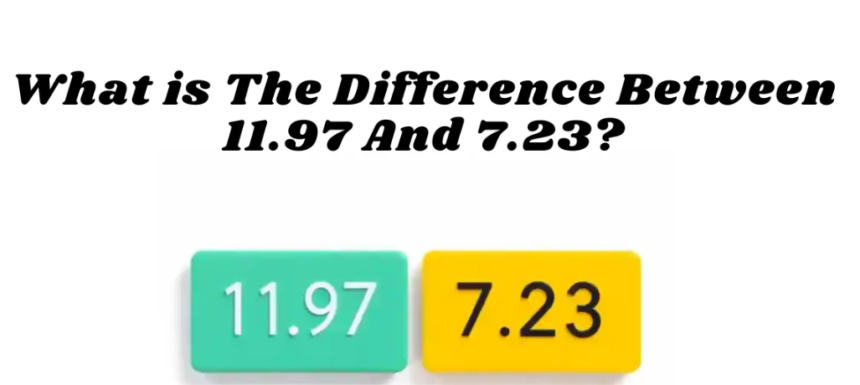When you come across numbers like 11.97 and 7.23, you may wonder what the actual difference is. This simple math question might seem straightforward, but it can raise questions for people unfamiliar with basic arithmetic. In this article, we will explain the difference between 11.97 and 7.23, break down the steps involved in solving it, and explore some additional facts about these numbers. Whether you’re trying to understand basic subtraction or learning how to interpret decimal numbers, this guide will help clarify the process.
Understanding the Question: What is the Difference Between 11.97 and 7.23?
The key to answering the question “What is the difference between 11.97 and 7.23?” lies in subtraction. To find the difference, we need to subtract 7.23 from 11.97.
Step-by-step process:
- Start with the larger number: 11.97
- Subtract the smaller number: 7.23
The formula looks like this:
Difference = 11.97 – 7.23
Now, let’s break it down further.
To subtract the decimals correctly, it is essential to line up the decimal points and perform the subtraction from right to left.
-
Subtraction of hundredths place (rightmost digit):
We start with the hundredths place (7th decimal) where we subtract 3 from 7. This gives us 4.
-
Subtraction of tenths place (next decimal):
Now we move to the tenths place (9th decimal). We subtract 2 from 9, which gives us 7.
-
Subtraction of whole numbers:
- Lastly, we subtract the whole numbers: 11 – 7, which gives us 4.
- So, the difference between 11.97 and 7.23 is:
- Difference = 4.74
Explanation of the Result
The difference between 11.97 and 7.23 is 4.74. This result is derived through basic subtraction. When you subtract 7.23 from 11.97, the answer is 4.74, meaning that 11.97 is 4.74 greater than 7.23.
Why Is This Difference Important?
Understanding how to calculate the difference between two numbers is an essential skill, especially when working with decimals. This knowledge is used frequently in real-world scenarios like budgeting, calculating prices, and handling measurements. It’s also useful in academic settings where precision is critical.
Real-World Examples of Using Differences
-
Shopping and Budgeting:
Let’s say you’re purchasing items worth $11.97 and $7.23, and you want to know how much more one item costs than the other. The difference (4.74) tells you exactly how much extra you would need to pay for the higher-priced item.
-
Distance and Measurement:
In measurements, knowing the difference between two values can help with adjustments. For instance, if two objects have distances of 11.97 meters and 7.23 meters, knowing the difference allows you to calculate how much more space is needed.
-
Time and Scheduling:
Suppose you have two time slots: one lasting 11.97 hours and another lasting 7.23 hours. The difference, 4.74 hours, helps you plan how much longer one task would take over the other.
Decimal Numbers: A Brief Overview
Before diving deeper into how to handle decimal differences, it is important to understand what decimal numbers are.
What Are Decimal Numbers?
Decimals are a way to express fractions in a base-10 number system. They are often used when precision is required in measurements, finances, or any field where accuracy is important. A decimal number consists of a whole part and a fractional part, separated by a decimal point. For example, 11.97 has a whole part (11) and a fractional part (0.97).
Why Do We Use Decimals?
Decimals are easier to work with compared to fractions in many cases. In the case of monetary values, decimals are used to represent cents in a dollar. Similarly, when dealing with measurements like weight or height, decimals allow for more precise calculations than whole numbers or fractions.
How to Subtract Decimals: A Quick Guide
Subtracting decimals might seem tricky at first, but with practice, it becomes an easy task. Here’s a simple guide:
-
Align the Decimal Points:
Place the decimal points of the two numbers one under the other.
-
Fill in Zeros (If Necessary):
If the decimal numbers have different decimal places, fill in zeros at the end of the shorter decimal part. For example, 11.97 can be written as 11.970 to match the length of 7.23.
-
Subtract from Right to Left:
Start with the rightmost digits and subtract them step by step.
-
Carry Over if Needed:
If you subtract a larger digit from a smaller one, carry over from the next place value.
Following these steps ensures that your subtraction is accurate and efficient.
Conclusion
What is the Difference Between 11.97 and 7.23? The difference between 11.97 and 7.23 is 4.74. This is calculated by subtracting 7.23 from 11.97, which involves basic subtraction of decimal numbers. Understanding how to perform such calculations is essential in many fields, including finance, science, and daily life. By following simple steps and grasping the concept of decimal numbers, you can quickly solve similar problems and apply this knowledge in various contexts.
FAQs
What is the method to subtract decimals?
To subtract decimals, align the decimal points, fill in zeros if necessary, and subtract from right to left.
How do I know when to carry over in decimal subtraction?
You need to carry over when a digit in the top number is smaller than the corresponding digit in the bottom number. For example, if you are subtracting 7 from 3, you would need to carry over from the next column.
Why is it important to understand decimal subtraction?
Understanding decimal subtraction is important because it is commonly used in everyday life for tasks such as budgeting, measuring distances, and managing finances.
What happens if I don’t line up the decimal points when subtracting?
If the decimal points are not aligned correctly, the subtraction will be inaccurate. It’s important to align them properly to get the correct result.
Can decimal subtraction be applied to real-world scenarios?
Yes, decimal subtraction is useful in various real-world scenarios, such as calculating price differences, measuring distances, and determining time differences.







